The AMD Ryzen 7 5700G, Ryzen 5 5600G, and Ryzen 3 5300G Review
by Dr. Ian Cutress on August 4, 2021 1:45 PM ESTMicrobenchmarks
Core-to-Core Latency
As the core count of modern CPUs is growing, we are reaching a time when the time to access each core from a different core is no longer a constant. Even before the advent of heterogeneous SoC designs, processors built on large rings or meshes can have different latencies to access the nearest core compared to the furthest core. This rings true, especially in multi-socket server environments.
But modern CPUs, even desktop and consumer CPUs, can have variable access latency to get to another core. For example, in the first-generation Threadripper CPUs, we had four chips on the package, each with 8 threads, and each with a different core-to-core latency depending on if it was on-die or off-die. This gets more complex with products like Lakefield, which has two different communication buses depending on which core is talking to which.
If you are a regular reader of AnandTech’s CPU reviews, you will recognize our Core-to-Core latency test. It’s a great way to show exactly how groups of cores are laid out on the silicon. This is a custom in-house test built by Andrei, and we know there are competing tests out there, but we feel ours is the most accurate to how quick an access between two cores can happen.
The Ryzen 7 5700G has the quickest thread-to-thread latency, however does offer a single slowest core-to-core latency. But compared to the 4000G series, having a single unified L3 cache reduces to core-to-core latency a good amount. The Ryzen 5 5300G has the slowest intracore latency, but the fastest average core-to-core.
Per-Core Power
One other angle to examine is how much power each core is drawing with respect to the rest of the chip. In this test, we run POV-Ray with a specific thread mask for a minute, and take a power reading 30 seconds into the test. We output the core power values from all cores, and compare them to the reported total package power.
The peak per-core power is shown as 15.2 W when one core is loaded on the Ryzen 7 5700G, and that comes down to ~8.8W when all cores are loaded. Interestingly this processor uses more power when six cores are loaded.
The Ryzen 5 5300G starts at 11.5 W for a single core, but then moves up to 12.3 W when three cores are loaded. It comes back down to 11.5 W when all four cores are loaded, but this ensures a consistent frequency (the 5300G has a 4.2 GHz Base and 4.4 GHz Turbo, explaining the small variation in loading).
Frequency Ramping
Both AMD and Intel over the past few years have introduced features to their processors that speed up the time from when a CPU moves from idle into a high-powered state. The effect of this means that users can get peak performance quicker, but the biggest knock-on effect for this is with battery life in mobile devices, especially if a system can turbo up quick and turbo down quick, ensuring that it stays in the lowest and most efficient power state for as long as possible.
Intel’s technology is called SpeedShift, although SpeedShift was not enabled until Skylake.
One of the issues though with this technology is that sometimes the adjustments in frequency can be so fast, the software cannot detect them. If the frequency is changing on the order of microseconds, but your software is only probing frequency in milliseconds (or seconds), then quick changes will be missed. Not only that, as an observer probing the frequency, you could be affecting the actual turbo performance. When the CPU is changing frequency, it essentially has to pause all compute while it aligns the frequency rate of the whole core.
We wrote an extensive review analysis piece on this, called ‘Reaching for Turbo: Aligning Perception with AMD’s Frequency Metrics’, due to an issue where users were not observing the peak turbo speeds for AMD’s processors.
We got around the issue by making the frequency probing the workload causing the turbo. The software is able to detect frequency adjustments on a microsecond scale, so we can see how well a system can get to those boost frequencies. Our Frequency Ramp tool has already been in use in a number of reviews.
In our test, the Ryzen 5 5600G jumps from 2700 to the turbo frequency in around a millisecond.


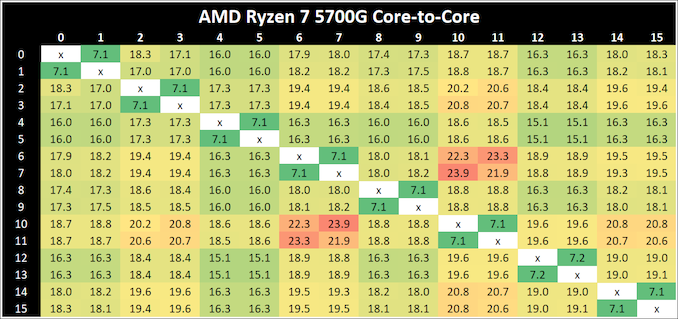
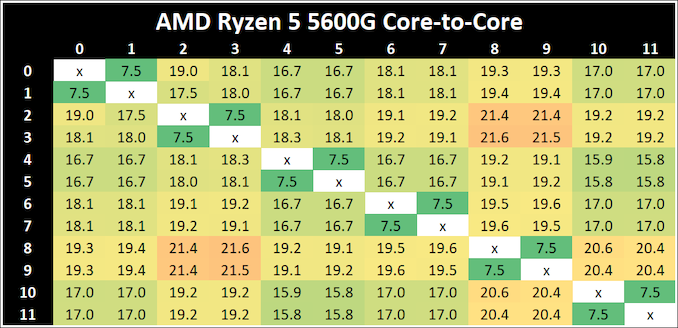
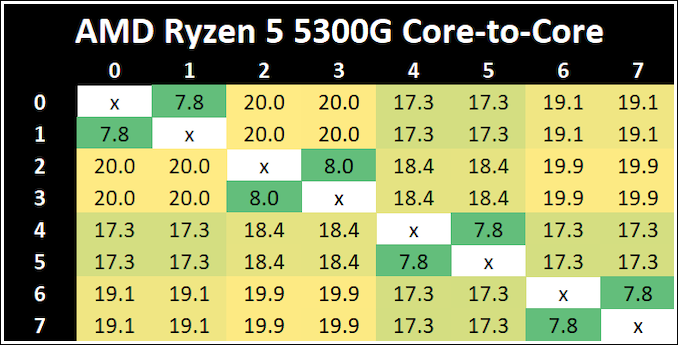
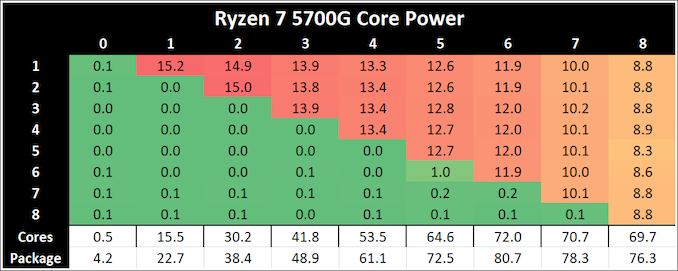

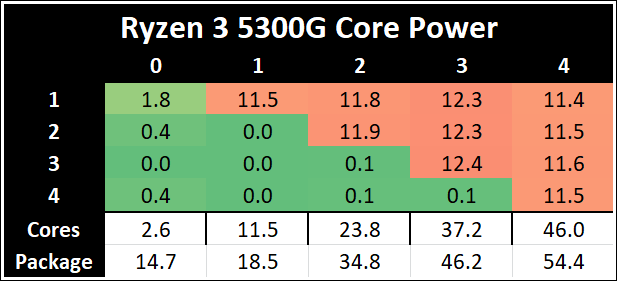
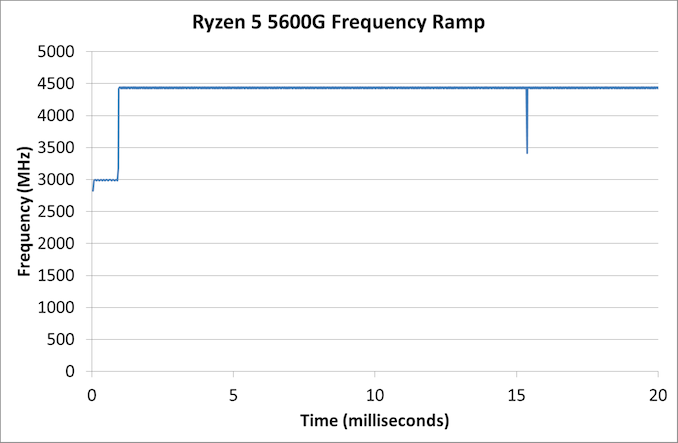








135 Comments
View All Comments
GeoffreyA - Friday, August 6, 2021 - link
Okay, that makes sense.19434949 - Friday, August 6, 2021 - link
Do you know if 5600G or 5700G can output 4k 120fps movie/video playback?GeoffreyA - Saturday, August 7, 2021 - link
Tested this now on a 2200G. Taking the Elysium trailer, I encoded a 10-second clip in H.264, H.265, and AV1 using FFmpeg. The original frame rate was 23.976, so using the -r switch, got it up to 120. Also, scaled the video from 3840x1606 to 3840x2160, and kept the audio (DTS-MA, 8 ch). On MPC-HC, they all ran smoothly. Rough CPU/GPU usage:H.264: 25% | 20%
H.265: 6% | 21%
AV1: 60% | 20%
So if Raven Ridge can hold up at 4K/120, Cezanne should have no problem. Note that the video was downscaled during playback, owing to the screen not being 4K. Not sure if that made it easier. 8K, choppy. And VLC, lower GPU usage but got stuck on the AV1 clip.
GeoffreyA - Sunday, August 8, 2021 - link
Something else I found. 10-bit H.264 seems to be going through software/CPU decoding, whereas 8-bit is running through the hardware, dropping CPU usage down to 6/8%. H.265 hasn't got the same problem. It could be the driver, the hardware, the player, or my computer.mode_13h - Monday, August 9, 2021 - link
> 10-bit H.264 seems to be going through software/CPU decoding...
> It could be the driver, the hardware, the player
It's quite likely the driver or a GPU hardware limitation. There's some nonzero chance it's the player, but I'd bet the player tries to use acceleration and then only falls back on software when that fails.
GeoffreyA - Tuesday, August 10, 2021 - link
Yes, quite likely.mode_13h - Monday, August 9, 2021 - link
> the video was downscaled during playback, owing to the screen not being 4K.> Not sure if that made it easier.
Not usually. I only have detailed knowledge of H.264, where hierarchical encoding is mostly aimed at adapting to different bitrates. That would never be enabled by default, because not only is it more work for the encoder, but it's also poorly supported by decoders and generates slightly less efficient bitstreams.
GeoffreyA - Tuesday, August 10, 2021 - link
"hierarchical encoding"That could be x264's b-pyramid, which, I think, is enabled most of the time. Apparently, allows B-frames to be used as references, saving bits. The stricter setting limits it to the Bluray spec.
GeoffreyA - Tuesday, August 10, 2021 - link
By the way, looking forward to x266 coming out. AV1 is excellent, but VVC appears to be slightly ahead of it.mode_13h - Wednesday, August 11, 2021 - link
> That could be x264's b-pyramidNo, I meant specifically Scalable Video Coding, which is what I thought, but I didn't want to cite the wrong term.
https://en.wikipedia.org/wiki/Advanced_Video_Codin...
The only way the decoder can opt to do less work is by discarding some layers of a SVC-encoded H.264 stream. Under any other circumstance, the decoder can't take any shortcuts without introducing a cascade of errors in all of the frames which reference the one being decoded.
> The stricter setting limits it to the Bluray spec.
I think blu-ray mainly limits which profiles (which are a collection of compression techniques) and levels (i.e. bitrates & resolutions) can be used, so that the bitstream can be decoded by all players and can be streamed off the disc fast enough.
I once tried authoring valid blu-ray video dics, but the consumer-grade tools were too limiting and the free tools were a mess to figure out and use. In the end, I found simply copying MPEG-2.ts files on a BD-R would play it every player I tested. I was mainly interested in using it for a few videos shot on a phone, plus a few things I recorded from broadcast TV.